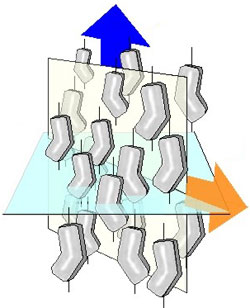A New Direction for Liquid Crystals

The liquid crystal in a flat-panel display consists of rod-shaped molecules that point in the same direction but spin randomly around their long axis. Two reports in the 9 April PRL prove that the molecules of a recently developed material align in not one but two directions. The results culminate a decades-long search for such a liquid crystal, which some researchers believe might respond faster in electronic devices than do current materials.
As their name suggests, liquid crystals have features of both liquids and solids. In the “nematic” phase used for displays, rod-shaped molecules swim about randomly, like liquid molecules, but they remain roughly parallel to one another. Because the rods are free to spin about their long axis, this phase is like the crowd of travelers standing around at a train station, mostly upright, but facing in various directions. In 1970 Marvin Freiser, then of IBM’s Thomas J. Watson Research Center in Yorktown Heights, New York, predicted that molecules that are long and flat–shaped like a ruler, rather than a pen–could form a different, “biaxial nematic” phase [1]. In this phase, the flat faces as well as the length of the molecules would be aligned, like the train station crowd facing the “arrivals” board as it is updated. Researchers began searching for the predicted phase in a variety of materials, hoping to learn more about liquid crystals and perhaps find new options for electronic devices.
Liquid crystal researchers did manage to create the biaxial nematic state with complex, soapy mixtures, and with flat molecules tied to a long polymer chain [2]. But for small molecules, the many claimed “sightings” of this phase have all turned out to be false alarms.
Ed Samulski, of the University of North Carolina in Chapel Hill, and his colleagues, had seen hints of the biaxial phase in molecules they made. These so-called rigid, bent-core molecules have a boomerang-shaped central core, with long, floppy, hydrocarbon chains attached to each end. Each molecule also has strongly charged parts, both positive and negative, which Samulski speculates may help to align neighbors with each other and stabilize the biaxial phase. But his team wanted to see the phase in the interior of the liquid crystal; earlier researchers had been fooled by effects at the walls of the container.
A team led by Satyendra Kumar of Kent State University in Ohio now demonstrates the biaxial phase in the interior by aiming an x-ray beam at the material and analyzing the “spots”–specific angles at which x rays scattered from different molecules reinforce one another. Such spots signal orderly molecular arrangements. The team saw two spots for the biaxial phase, whereas a single spot would be expected for the ordinary nematic phase.
Samulski’s team, in the same issue of PRL, confirms those results with nuclear magnetic resonance (NMR), a technique that uses radio waves to jiggle atomic nuclei in a magnetic field. The team added molecules containing deuterium to the liquid crystal. The precise radio frequency at which deuterium nuclei jiggle is sensitive to the detailed arrangement of nearby molecules. Samulski says that this “unambiguous” biaxial nematic behavior for small molecules “has eluded liquid crystallographers for more than three decades.”
David Walba of the University of Colorado in Boulder says the result is “really cool, after all these years.” The result won’t lead to new devices any time soon, says Kumar, although new types of devices may eventually be possible. Samulski says it should be easier to twist the molecules than to turn them end over end, so they might respond faster to electrical signals than do conventional liquid crystals.
–Don Monroe
Don Monroe is a freelance science writer in Murray Hill, New Jersey.
References
- M. J. Freiser, “Ordered States of a Nematic Liquid,” Phys. Rev. Lett. 24, 1041 (1970) predicted the existence of a biaxial phase
- K. Severing and K. Saalwächter, “Biaxial Nematic Phase in a Thermotropic Liquid-Crystalline Side-Chain Polymer,” Phys. Rev. Lett. 92, 125501 (2004)
More Information
some pretty pictures of liquid crystals at MICSCAP


